Numerical Simulation of Catalytic Methane Combustion in Al2O3 Directional Nanotubes Modified by Pt and Pd Catalyst
Abstract
:1. Introduction
2. Materials and Methods
2.1. Physical Model and Working Mechanism
2.2. Fluid Turbulence Model
- (1)
- Mass conservation equation:
- (2)
- Momentum conservation equation:
- (3)
- Energy-conservation equation:
2.3. Chemical Reaction Model
2.4. Chemical Reaction Mechanism
- (1)
- Body-reaction mechanism [29]
- (2)
- Wall reaction mechanism [30]
3. Results and Discussion
3.1. Analysis of the Microporous Body-Reaction Combustion Simulation
3.1.1. Body-Reaction Temperature Field
3.1.2. Species Mass Fraction
- (1)
- Distribution of the reactant mass fraction
- (2)
- Distribution of product mass fraction
3.1.3. Kinetic Rate of Reaction
3.1.4. Turbulent Rate of Reaction
3.1.5. Total Reaction Rate
3.2. Analysis of the Microporous Surface Reaction Combustion Simulation
3.2.1. Surface Reaction Temperature Field
3.2.2. Species Mass Fraction
- (1)
- Distribution of the reactant mass fraction
- (2)
- Distribution of the product mass fraction
3.2.3. Total Reaction Rate
3.3. Analysis of the Impact of Process Parameters on Combustion Reaction
3.3.1. Influence of Process Parameters on Bulk Reaction
- (1)
- Inlet velocity
- (2)
- Inlet concentration
- (3)
- Pore size
3.3.2. Effect of Process Parameters on Surface Reaction
- (1)
- Inlet velocity
- (2)
- Inlet concentration
- (3)
- Pore size
4. Conclusions
Author Contributions
Funding
Institutional Review Board Statement
Informed Consent Statement
Data Availability Statement
Conflicts of Interest
References
- Li, S. Methane Gas Sensor Based on Gallium Nitride Nanowires. Master’s Thesis, Dalian University of Technology, Dalian, China, 2020. [Google Scholar] [CrossRef]
- Shemshad, J.; Aminossadati, S.M.; Kizil, M.S. A review of developments in near infrared methane detection based on tunable diode laser. Sens. Actuators B Chem. 2012, 171, 77–92. [Google Scholar] [CrossRef]
- Si, R.; Niu, Y.; Wang, L.; Huang, Z.; Jia, Q. Research progress on dynamic characteristics of coal mine gas and coal dust explosion. Eng. Blasting 2023, 29, 30–39. [Google Scholar] [CrossRef]
- Liu, N.; Shu, Z.; Sui, R.; Wang, T.; Cao, Z. Research progress of methane catalytic combustion sensor based on MEMS technology. Coal Chem. Ind. 2022, 45, 131–135+147. [Google Scholar] [CrossRef]
- Shen, B.; Song, X. Improvement of response performance of methane sensor by pore confined catalytic system. J. Heilongjiang Univ. Sci. Technol. 2021, 31, 295–301. [Google Scholar]
- Mazloum-Ardakani, M.; Sheikh-Mohseni, M.A. Carbon Nanotubes in Electrochemical Sensors; InTech: Vienna, Austria, 2011. [Google Scholar]
- Zhang, H.; Guo, J.; Shi, Y. Study on catalyst deactivation mechanism of thermal combustion gas sensor. Sens. Microsyst. 2007, 1, 45–47. [Google Scholar] [CrossRef]
- Wang, Y. Study on the Influence of Gas Catalytic Element Preparation Method on Performance. Ph.D. Thesis, China University of Mining and Technology, Xuzhou, China, 2012. [Google Scholar]
- Li, Y.; Wang, H.; Chen, Y.; Yang, M. A multi-walled carbon nanotube/palladium nanocomposite prepared by a facile method for the detection of methane at room temperature. Sens. Actuators B Chem. 2008, 132, 155–158. [Google Scholar] [CrossRef]
- Cantalini, C.; Valentini, L.; Armentano, I.; Kenny, J.; Lozzi, L.; Santucci, S. Carbon nanotubes as new materials for gas sensing applications. J. Eur. Ceram. Soc. 2004, 24, 1405–1408. [Google Scholar] [CrossRef]
- Chen, X.; Huang, Z.; Li, J.; Wu, C.; Wang, Z.; Cui, Y. Methane gas sensing behavior of lithium ion doped carbon nanotubes sensor. Vacuum 2018, 154, 120–128. [Google Scholar] [CrossRef]
- Zhang, H.; Shen, B.; Hu, W.; Liu, X. Research on a Fast-Response Thermal Conductivity Sensor Based on Carbon Nanotube Modification. Sensors 2018, 18, 2191. [Google Scholar] [CrossRef]
- Fotooh, F.K.; Nayeri, M. Methane adsorption on the surface of metal (Fe, Ni, Pd) decorated SWCNT: A density functional theory (DFT) study. Surf. Sci. 2021, 713, 121913. [Google Scholar] [CrossRef]
- Roslyakov, I.; Kolesnik, I.; Evdokimov, P.; Skryabina, O.; Garshev, A.; Mironov, S.; Stolyarov, V.; Baranchikov, A.; Napolskii, K. Microhotplate catalytic sensors based on porous anodic alumina: Operando study of methane response hysteresis. Sens. Actuators B Chem. 2020, 330, 129307. [Google Scholar] [CrossRef]
- Tang, B.; Shi, Y.; Li, J.; Tang, J.; Feng, Q. Design, Simulation, and Fabrication of Multilayer Al2O3 Ceramic Micro-Hotplates for High Temperature Gas Sensors. Sensors 2022, 22, 6778. [Google Scholar] [CrossRef]
- Kulhari, L.; Khanna, P.K. Design, simulation and fabrication of LTCC-based microhotplate for gas sensor applications. Microsyst. Technol. 2018, 24, 2169–2175. [Google Scholar] [CrossRef]
- Kharbanda, D.K.; Suri, N.; Khanna, P.K. Design, fabrication and characterization of laser patterned LTCC micro hotplate with stable interconnects for gas sensor platform. Microsyst. Technol. 2018, 25, 2197–2204. [Google Scholar] [CrossRef]
- Yuan, Z.; Yang, F.; Li, Y.; Zhang, J.; Meng, F. Characterization of a novel microhotplate for application in a silicon-based nanofilm gas sensor. Instrum. Sci. Technol. 2022, 51, 45–58. [Google Scholar] [CrossRef]
- Venkataraman, A.; Amadi, E.V.; Chen, Y.; Papadopoulos, C. Carbon Nanotube Assembly and Integration for Applications. Nanoscale Res. Lett. 2019, 14, 220. [Google Scholar] [CrossRef]
- Tafete, G.A.; Thothadri, G.; Abera, M.K. A review on carbon nanotube-based composites for electrocatalyst applications. Fuller. Nanotub. Carbon Nanostruct. 2022, 30, 1075–1083. [Google Scholar] [CrossRef]
- Shen, B.; Zhang, H.; Liu, X.; Cao, S.; Yang, P. Fabrication and Characterizations of Catalytic Methane Sensor Based on Microelectromechanical Systems Technology. J. Nanoelectron. Optoelectron. 2018, 13, 1816–1822. [Google Scholar] [CrossRef]
- Hadano, H.; Miyagi, A.; Okuno, T.; Nagawa, Y.; Ishiguro, Y. Development of a Catalytic Combustion Type Gas Sensor with Low Power Consumption. ECS Trans. 2016, 75, 195–198. [Google Scholar] [CrossRef]
- Li, M.; Song, H.; Wang, L.; Yang, M. Catalytic combustion gas sensor based on MEMS technology. Mod. Inf. Technol. 2018, 2, 179–181. [Google Scholar]
- Dai, G.; Xu, Y.; Wu, Q.; Shen, Y.; Han, D.; Deng, X. Research on bending strain measurement sensitivity based on Wheatstone bridge. J. Nanchang Univ. Sci. Ed. 2022, 46, 66–71. [Google Scholar] [CrossRef]
- Subramani, M.; Arumugam, D.; Ramasamy, S. Revealing the interfacial phenomenon of metal-hydride formation and spillover effect on C48H16 sheet by platinum metal catalyst (Pt (n = 1 − 4)) for hydrogen storage enhancement. Int. J. Hydrogen Energy 2022, 48, 4016–4034. [Google Scholar] [CrossRef]
- Yang, H. Molecular Dynamics Simulation of the Microscopic Properties of Water Molecules in Carbon Nanotubes. Master’s Thesis, North University of China, Taiyuan, China, 2015. [Google Scholar]
- Wang, P. Numerical Simulation Study of Low NOx Mechanism of Methane Catalytic Combustion. Master’s Thesis, Beijing University of Chemical Technology, Beijing, China, 2019. [Google Scholar] [CrossRef]
- Wen, Z. FLUENT Fluid Computing Applications Tutorial, 2nd ed.; Tsinghua University Press: Beijing, China, 2013. [Google Scholar]
- Wang, D. Molecular Dynamics Simulation of Molecular Diffusion Properties in Nanopores. Master’s Thesis, North University of China, Taiyuan, China, 2016. [Google Scholar]
- Jones, J.E. On the Determination of Molecular Fields. III. From Crystal Measurements and Kinetic Theory Data. Series A, Containing Papers of a Mathematical and Physical Character. Proc. R. Soc. Lond. 1924, 106, 709–718. [Google Scholar]
- Xue, L.J.; Zhang, D.; Wei, J.; Liu, X.M. Pore-limiting effect of catalysts. Adv. Chem. 2016, 28, 450–458. [Google Scholar]
- Keipi, T.; Tolvanen, K.E.; Tolvanen, H.; Konttinen, J. Thermo-catalytic decomposition of methane: The effect of reaction parameters on process design and the utilization possibilities of the produced carbon. Energy Convers. Manag. 2016, 126, 923–934. [Google Scholar] [CrossRef]
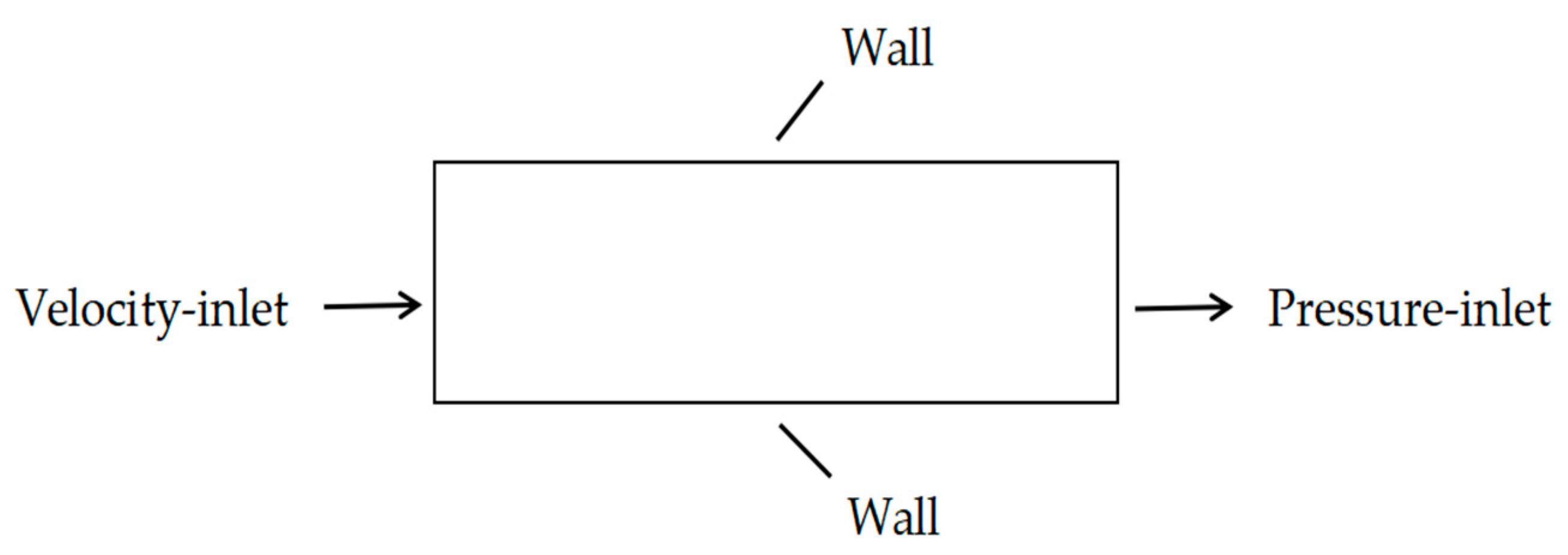
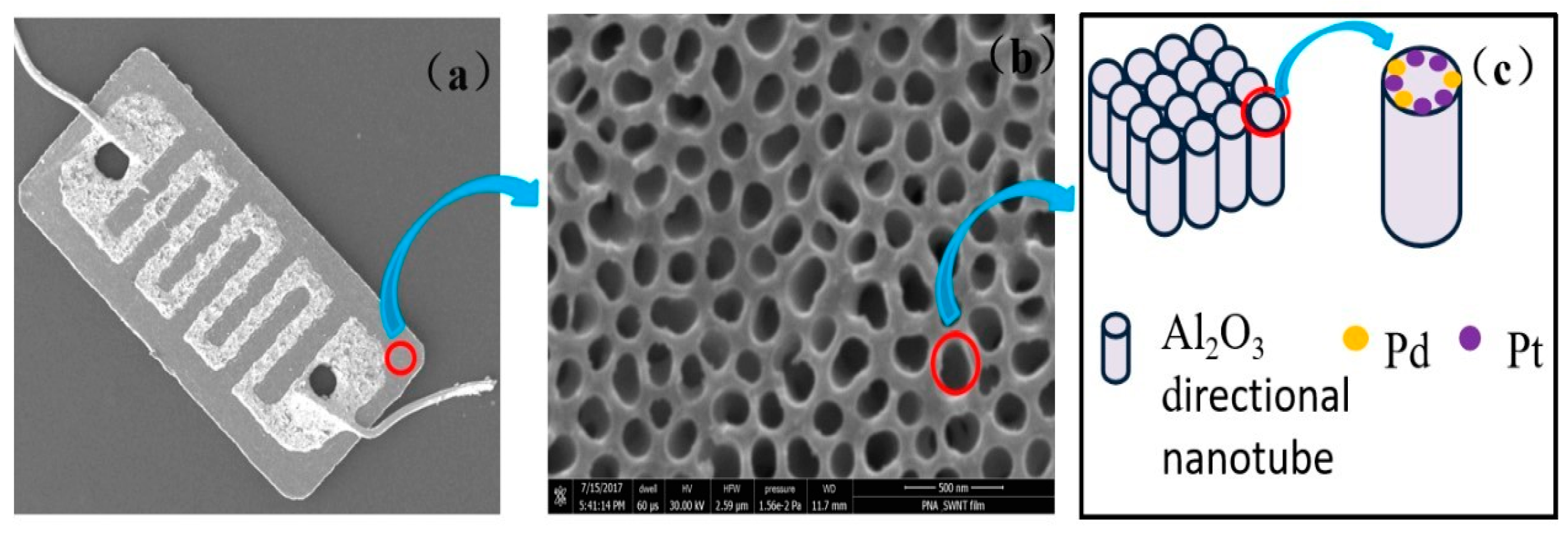



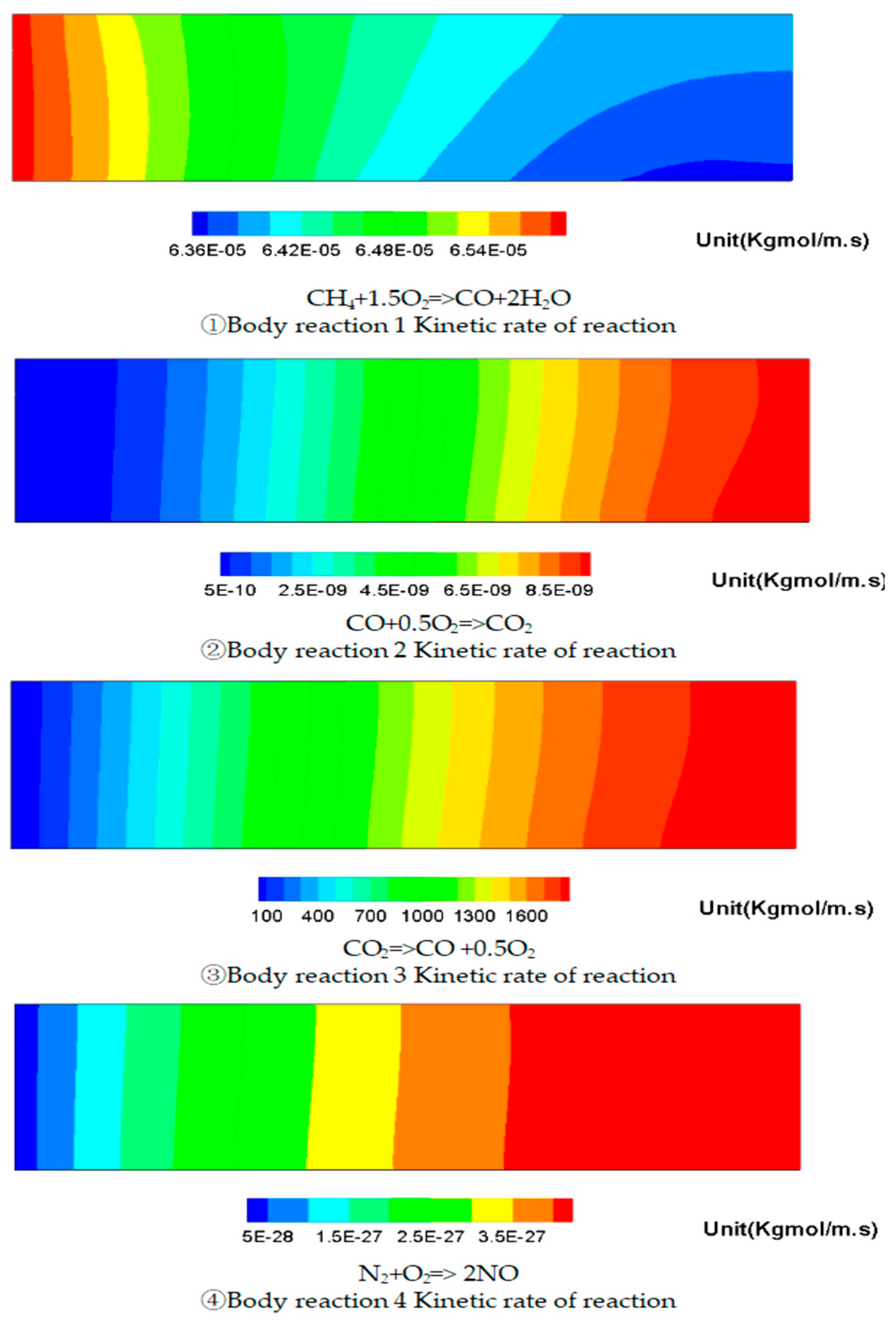
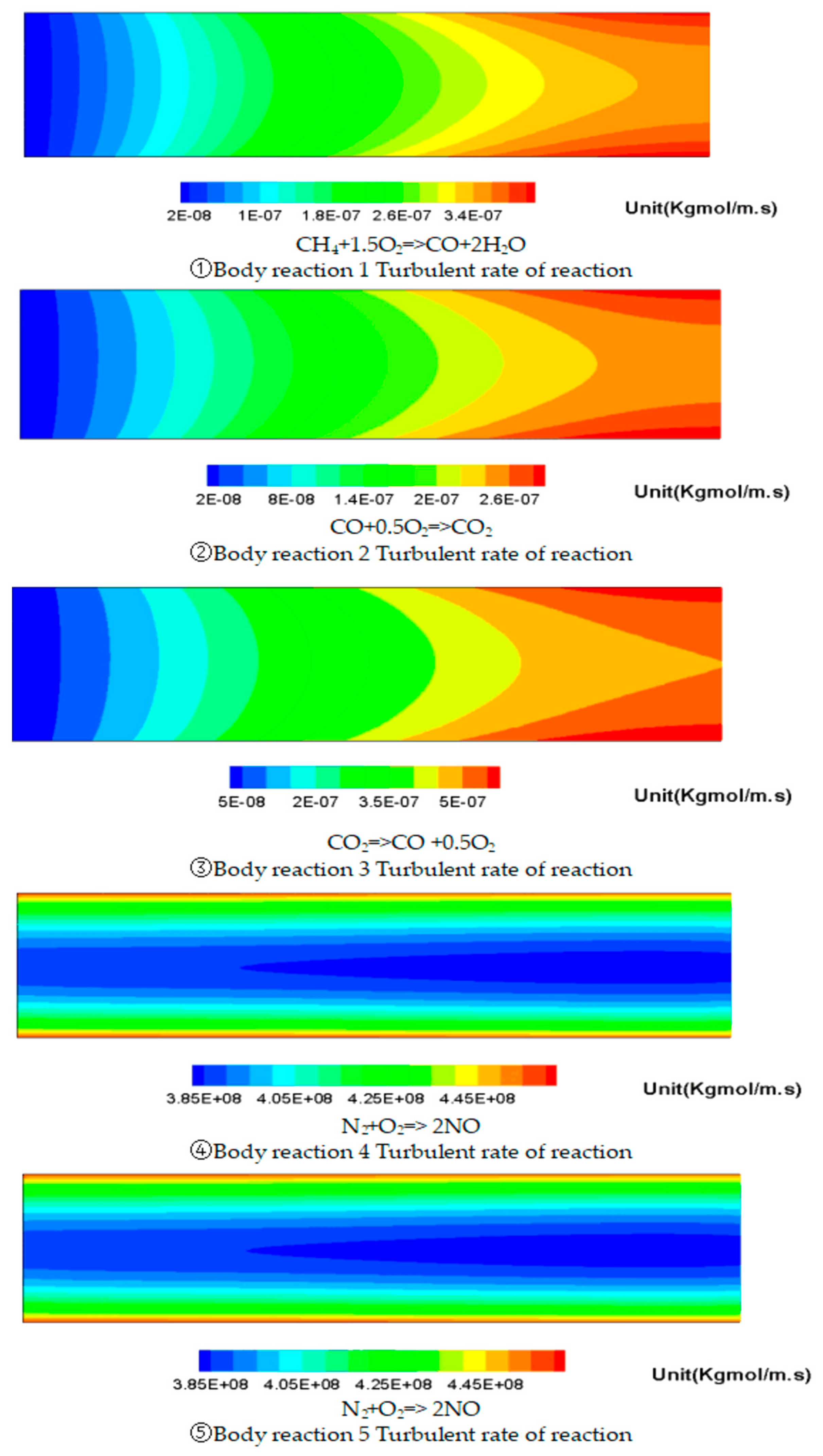

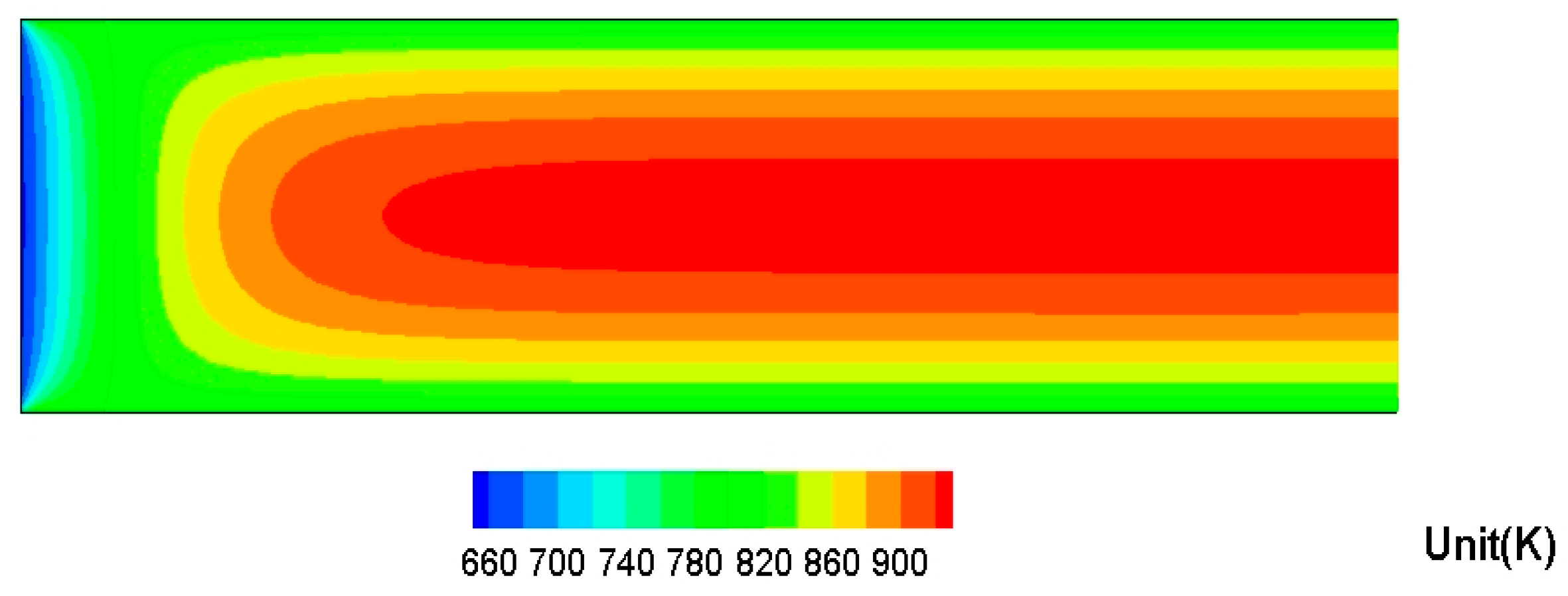


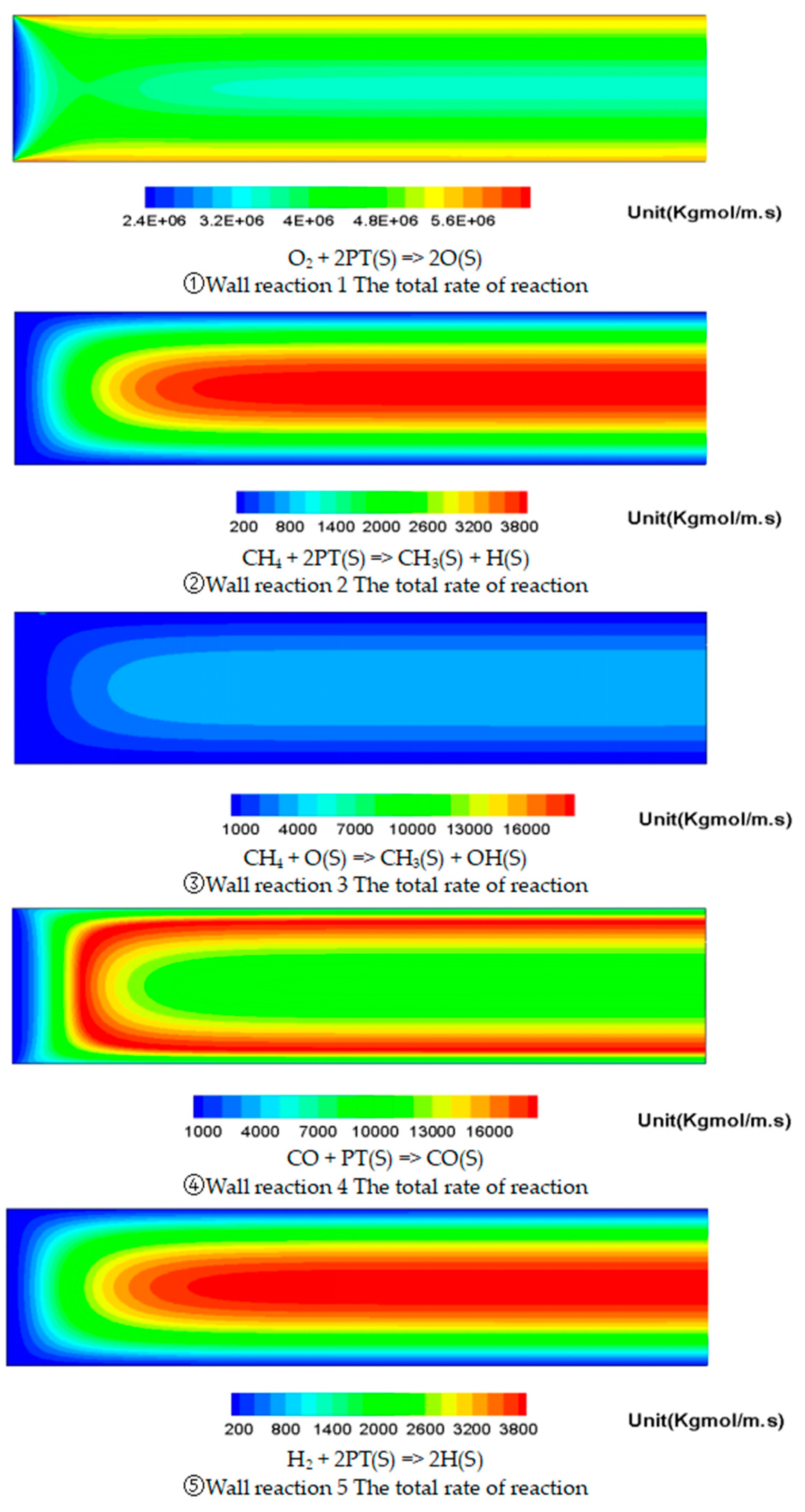
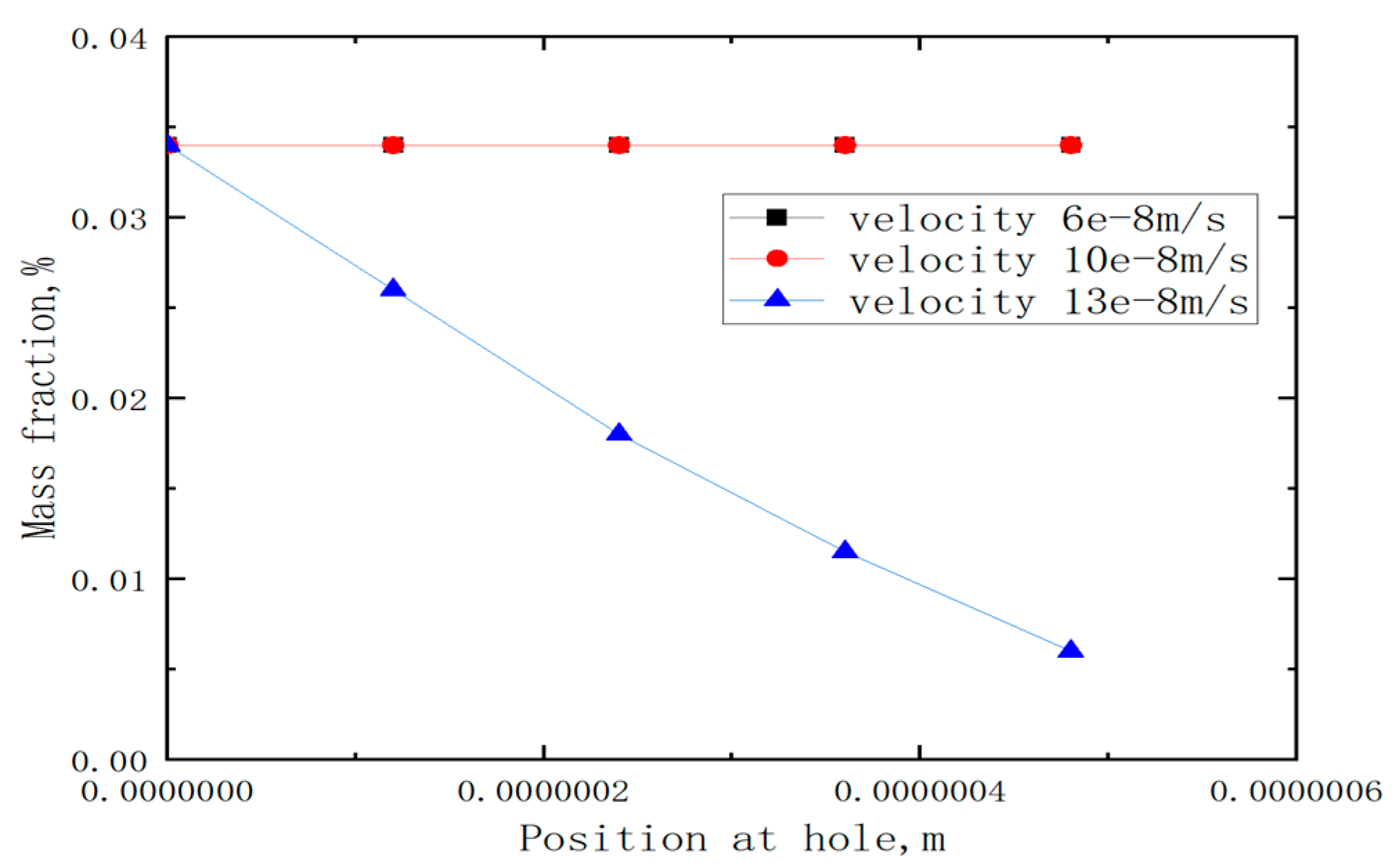
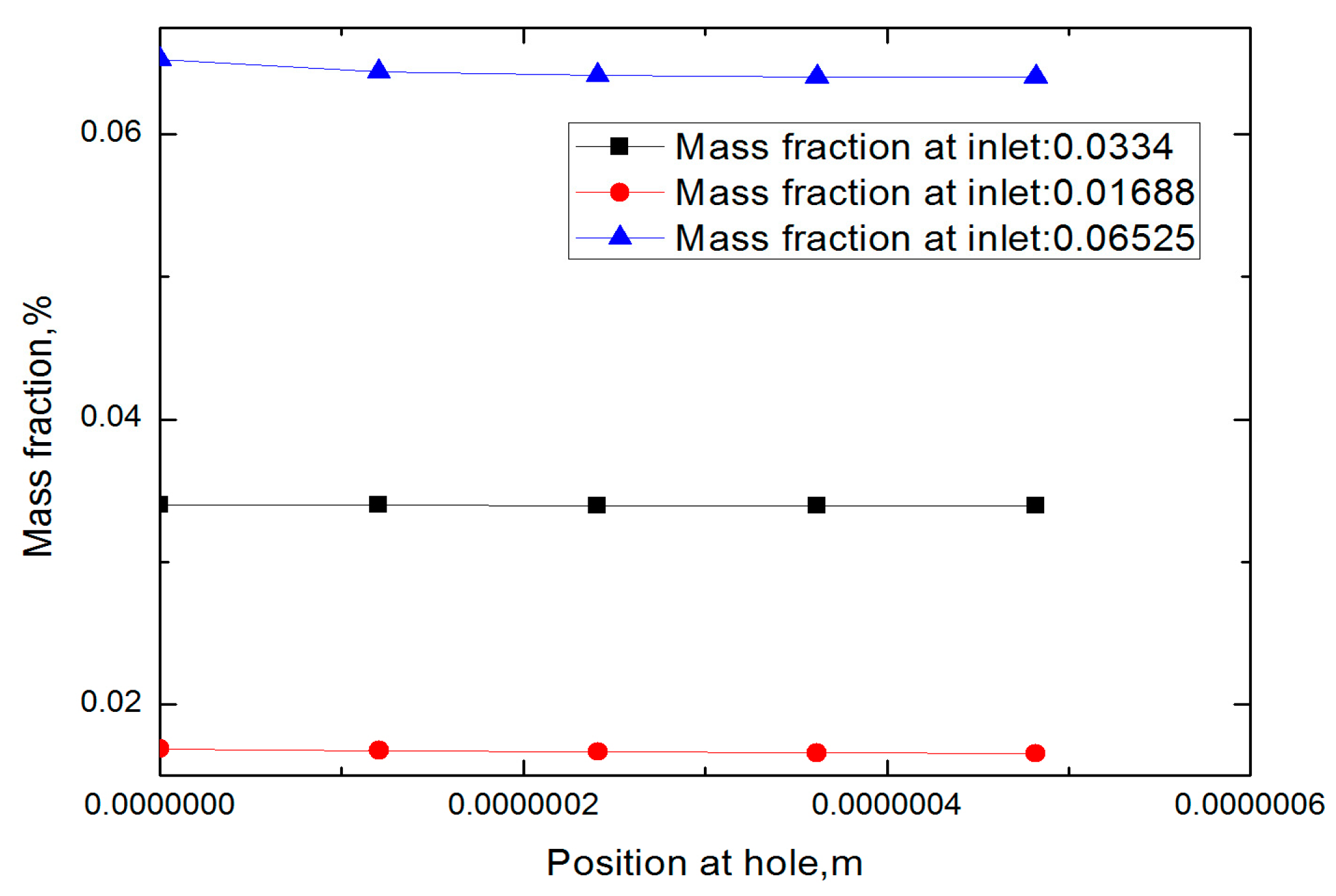

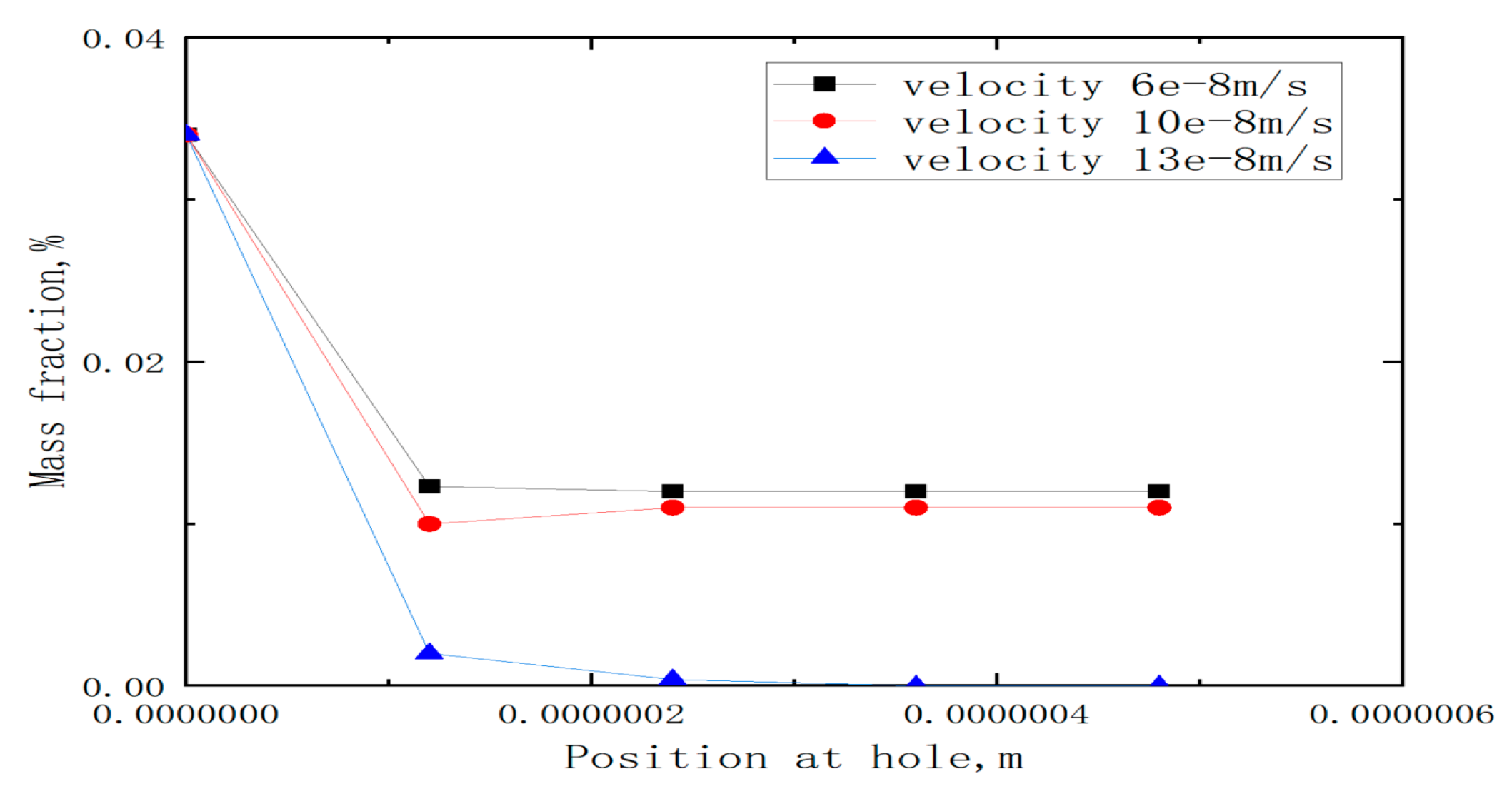
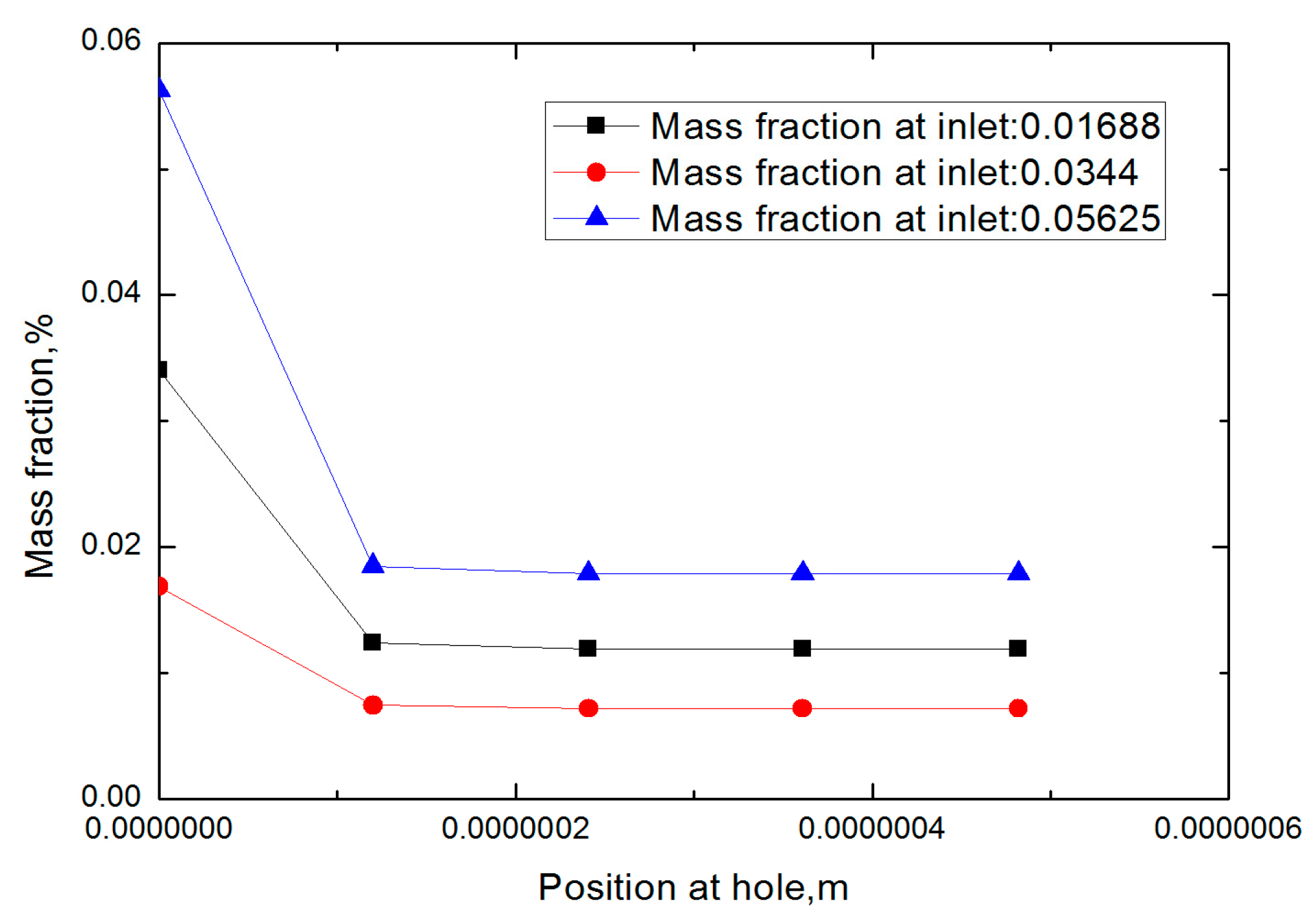
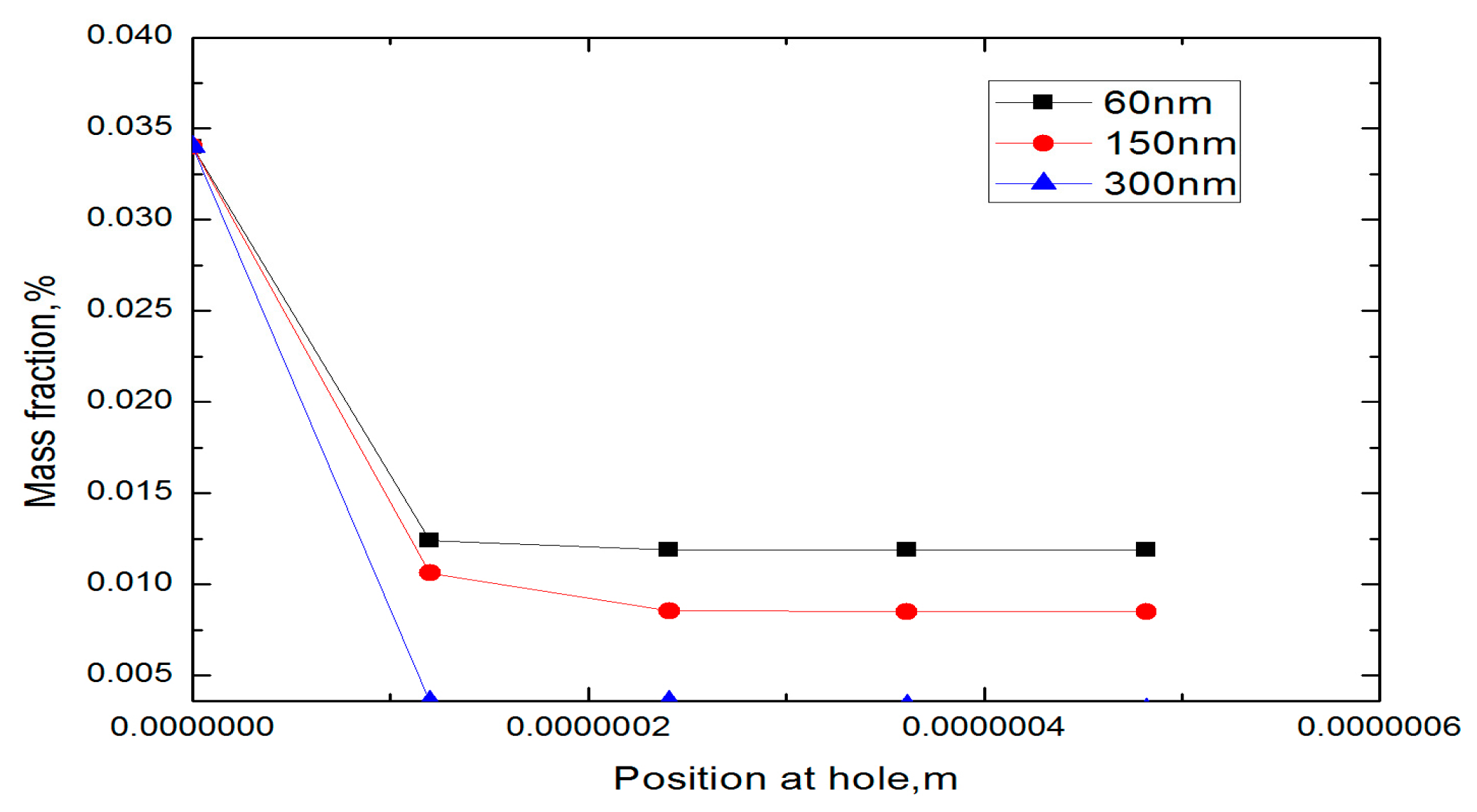
| Reaction Serial Number | Response Equation | Pre-Exponential Factor (A,m.mol.s) | Temperature Index (β) | Activation Energy Ea (J/mol) | Reaction Rate Index |
|---|---|---|---|---|---|
| 1 | CH4 + 1.5O2 ≥ CO + 2H2O | 1.6596 × 1015 | 0.000 | 1.72 × 108 | FORD/CH4 1.46/O2 0.5217/ |
| 2 | CO + 0.5O2 ≥ CO2 | 7.9799 × 1014 | 0.000 | 9.654 × 107 | FORD/CO 1.6904/O2 1.57/ |
| 3 | CO2 ≥ CO + 0.5O2 | 2.2336 × 1014 | 0.000 | 5.1774 × 108 | |
| 4 | N2 + O2 ≥ 2NO | 8.8308 × 1023 | 0.000 | 4.4366 × 108 | |
| 5 | N2 + O2 ≥ 2NO | 9.2683 × 1014 | −0.500 | 5.727 × 108 |
| Reaction Serial Number | Response Equation | Pre-Exponential Factor (m.mol.s) | Cover Degree | Temperature Index | Activation Energy (J/mol) | Speed Index |
|---|---|---|---|---|---|---|
| 1 | O2 + 2PT(S) ≥ 2O(S) | - | 0.003 | 0 | 0 | |
| 2 | CH4 + 2PT(S) ≥ CH3(S) + H(S) | - | 0.15 | 9.654 × 107 | 28,000.00 | FORD/PT(S) 2.3/ |
| 3 | CH4 + O(S) ≥ CH3(S) + OH(S) | - | 0.43 | 0 | 59,200.00 | |
| 4 | CO + PT(S) ≥ CO(S) | - | 0.840 | 0 | 0 | FORD/PT(S) 2/ |
| 5 | H2 + 2PT(S) ≥ 2H(S) | - | 0.046 | 0.00 | 0.00 | FORD/PT(S) 1.0/ |
| 6 | OH + PT(S) ≥ OH(S) | - | 1.00 | 0.0 | 0.0 | |
| 7 | H2O + PT(S) ≥ H2O(S) | - | 0.5 | 0.0 | 0.0 | |
| 8 | CH3(S) + PT(S) ≥ CH2(S) + H(S) | 1.0 × 1021 | - | 0.00 | 20,000.0 | |
| 9 | CH2(S) + PT(S) ≥ CH(S) + H(S) | 1.0 × 1021 | - | 0.00 | 20,000.0 | |
| 10 | CH(S) + PT(S) ≥ C(S) + H(S) | 1.0 × 1021 | - | 0.00 | 20,000.0 | |
| 11 | H(S) + O(S) = OH +2PT(S) | 1.0 × 1020 | - | 0.00 | 10,500.0 | |
| 12 | OH(S) = H(S) +O(S) | 1.0 × 1012 | - | 0.00 | 20,800.0 | |
| 13 | H(S) + OH(S) = H2O(S) | 1.0 × 1021 | - | 0.00 | 62,500.0 | |
| 14 | OH(S) + OH(S) = H2O(S) + O(S) | 1.0 × 1020 | - | 0.00 | 51,250.0 | |
| 15 | H2O(S) ≥ H(S) + OH(S) | 1.0 × 1013 | - | 0.00 | 51,200.0 | |
| 16 | C(S) + O(S) ≥ CO(S) | 5.0 × 1020 | - | 0.00 | 62,500.0 | |
| 17 | CO(S) ≥ C(S) + O(S) | 1.0 × 1013 | - | 0.00 | 156,500.0 | |
| 18 | CO(S) + O(S) ≥ CO + PT(S) | 4.0 × 1020 | - | 0.00 | 49,140.0 | |
| 19 | 2O(S) ≥ O2 + 2PT(S) | 1.0 × 1021 | - | 0.00 | 21,600.0 | |
| 20 | CO(S) ≥ CO + 2PT(S) | 8.5 × 1012 | - | 0.00 | 152,500.0 | |
| 21 | 2H(S) ≥ H2 + 2PT(S) | 5.0 × 1020 | - | 0.00 | 67,400.0 | |
| 22 | OH(S) ≥ OH + PT(S) | 1.5 × 1013 | - | 0.00 | 192,800.0 | |
| 23 | H2O(S) ≥ H2O + PT(S) | 1.0 × 1013 | - | 0.00 | 45,000.0 |
| Inlet Velocity (m/s) | Equivalence Ratio | CH4 Mass Fraction (%) | O2 Mass Fraction (%) | Pore Size (nm) | Wall Shear | Outlet (atm) |
|---|---|---|---|---|---|---|
| (1) 6 × 10−8 | (I) 0.3 | 0.016875 | 0.225 | (a) 60 | Adiabatic | 1 |
| (2) 1 × 10−7 | (II) 0.6 | 0.034 | 0.225 | (b) 150 | Adiabatic | 1 |
| (3) 13 × 10−8 | (III) 1 | 0.05625 | 0.225 | (c) 300 | Adiabatic | 1 |
| Inlet Velocity | Inlet Methane Mass Fraction | Outlet Methane Mass Fraction | Combustion Ratio (%) |
|---|---|---|---|
| 6 × 10−8 | 0.034 | 0.03391 | 0.27 |
| 1 × 10−7 | 0.034 | 0.033997 | 0.0088 |
| 13 × 10−8 | 0.034 | 0.0055258 | 83.7 |
| Inlet Concentration | Inlet Methane Mass Fraction | Outlet Methane Mass Fraction | Combustion Ratio (%) |
|---|---|---|---|
| 1.69 × 10−2 | 1.687500067 × 10−2 | 1.653965376 × 10−2 | 1.99 |
| 3.40 × 10−2 | 3.400000185 × 10−2 | 3.391203284 × 10−2 | 0.26 |
| 6.53 × 10−2 | 6.525000185 × 10−2 | 6.399093568 × 10−2 | 1.93 |
| Pore Size | Inlet Methane Mass Fraction | Outlet Methane Mass Fraction | Combustion Ratio (%) |
|---|---|---|---|
| 60 nm | 3.400000185 × 10−2 | 0.03391203284 | 0.26 |
| 150 nm | 3.400000185 × 10−2 | 0.03393090516 | 0.20 |
| 300 nm | 3.400000185 × 10−2 | 0.03390500322 | 0.28 |
| Inlet Velocity | Inlet Methane Mass Fraction | Outlet Methane Mass Fraction | Combustion Ratio, % |
|---|---|---|---|
| 6 × 10−8 | 0.03400000185 | 0.01191107742 | 65.0 |
| 1 × 10−7 | 0.03400000185 | 0.01071531605 | 68.5 |
| 13 × 10−8 | 0.03400000185 | 0.00000363869 | 100 |
| Inlet Concentration | Inlet Methane Mass Fraction | Outlet Methane Mass Fraction | Combustion Ratio, (%) |
|---|---|---|---|
| 0.01687500067 | 0.01687500067 | 0.00717461854 | 57.5 |
| 0.03400000185 | 0.03400000185 | 0.01191107742 | 65.0 |
| 0.05624999851 | 0.05624999851 | 0.01790973172 | 68.2 |
| Pore Size | Inlet Methane Mass Fraction | Outlet Methane Mass Fraction | Combustion Ratio, % |
|---|---|---|---|
| 60 nm | 3.400000185 × 10−22 | 0.0129 | 62.1 |
| 150 nm | 3.400000185 × 10−2 | 0.0085 | 75.0 |
| 300 nm | 3.400000185 × 10−2 | 0.0031 | 90.9 |
Disclaimer/Publisher’s Note: The statements, opinions and data contained in all publications are solely those of the individual author(s) and contributor(s) and not of MDPI and/or the editor(s). MDPI and/or the editor(s) disclaim responsibility for any injury to people or property resulting from any ideas, methods, instructions or products referred to in the content. |
© 2023 by the authors. Licensee MDPI, Basel, Switzerland. This article is an open access article distributed under the terms and conditions of the Creative Commons Attribution (CC BY) license (https://creativecommons.org/licenses/by/4.0/).
Share and Cite
Shen, B.; Zhou, T.; Liu, X.; Qin, X.; Li, W. Numerical Simulation of Catalytic Methane Combustion in Al2O3 Directional Nanotubes Modified by Pt and Pd Catalyst. Appl. Sci. 2023, 13, 6547. https://doi.org/10.3390/app13116547
Shen B, Zhou T, Liu X, Qin X, Li W. Numerical Simulation of Catalytic Methane Combustion in Al2O3 Directional Nanotubes Modified by Pt and Pd Catalyst. Applied Sciences. 2023; 13(11):6547. https://doi.org/10.3390/app13116547
Chicago/Turabian StyleShen, Bin, Tianshun Zhou, Xinlei Liu, Xianli Qin, and Wei Li. 2023. "Numerical Simulation of Catalytic Methane Combustion in Al2O3 Directional Nanotubes Modified by Pt and Pd Catalyst" Applied Sciences 13, no. 11: 6547. https://doi.org/10.3390/app13116547






